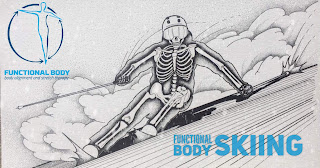Tom Gellie's Blog Somatic Skiing: The Bones of Skiing
 |
| My talented friend Laurie drew me a skiing Skeleton. This is how I have been thinking about my skiing for the last three years. |
First off why have I called it Somatic Skiing?? Somatic by definition means: "Part of, or relating to the body of an organism". Somatic Skiing then being relating the body to skiing. From the very beginning of my skiing career I have been interested in how our bodie's move and function. The more I have come to understand about our joints, muscles and neurology the more I have found my skiing and other physical activities have become refined and enjoyable on so many levels. Almost to the point that skiing is a form of mindfulness or meditation. A way for me to really connect with my body and listen to whats going on. Knowledge and a deeper understanding of the body has also given me freedom to explore training in my own way. Test out ideas and theories for myself as opposed to taking what I've learnt from others for granted. It's been a very interesting journey that I feel has resulted in demystifying and simplifying a lot of the information and training I've experienced over the years.
 |
| Biomechanics presentation getting people involved. |
So what to share in this maiden blog post? Well here is one simple piece that has helped me begin to simplify skiing. Get to know your bones! Why? For a start wouldn't you want to know what exactly was possible for you to move at each part of your body in order to then work out what was moving well and what was not? Second, There are 206 bones and amazingly 360 joints! Thats a lot of possible joint motions we could be using. From my own experience the more I have awareness and control of these joints the easier and more efficient my sports become. Finally knowing the bones and their subsequent joints allows us to be more accurate. You can clearly see if a joint is moving or not however its much harder to see if a muscle is contracted, lengthened or relaxed and how much effort is going into that muscle to perform a movement. So referencing bones and joints keeps things simple. The muscles tend to just react to our bones anyway (Cheers Gary Ward for helping me to realise this).
 |
| 360 joints. Lots of possible motions. Are your joints functioning at their fullest potential? |
Keeping the first piece short I encourage you to go away after reading this post and see if you really are aware of your bones or are you more concerned with feeling muscles. Or not aware anything at all?! Start with your skiing stance (on snow or just imagine it in your living room) and see if you can create bend at the ankle joint in three different ways! Because flexing the ankle can be done three ways:
1- Move the lower leg closer to the top of the foot without moving the top of foot
2- Move the top of the foot closer to the lower leg, not moving the lower leg.
3- Move both the lower leg and the top of the foot closer together.
 |
Lower leg to foot
 |
| Foot to lower leg |
 |
| lower leg and foot both towards each other |
If you begin to realise that flexing your ankles can be done in more ways than one you are already beginning to be be more versatile and create options for yourself depending on what your goals are. There are no wrong movements just many possibilities. Figure out the virtues of each option and you now have more freedom and the ability to self analyse. Post your comments as to whether or not you've ever thought about flexing your ankle in three different ways before and which way seems most strange to you.
Thanks for following
Tom
www.functionalbody.com.au


Comments
Post a Comment